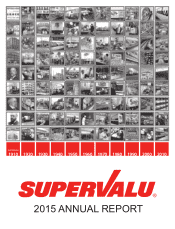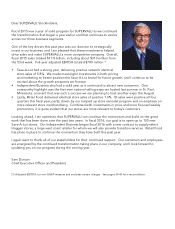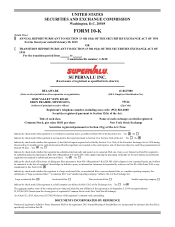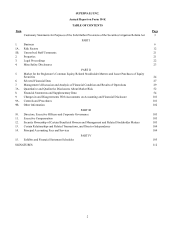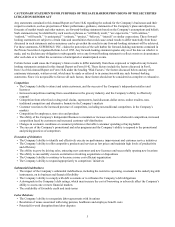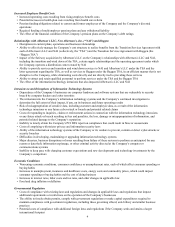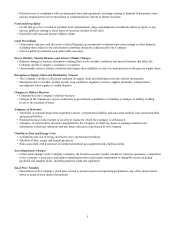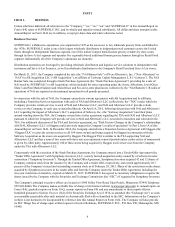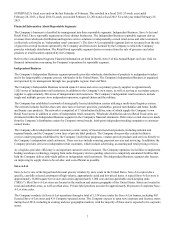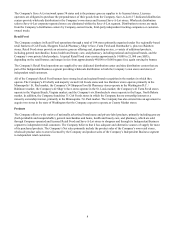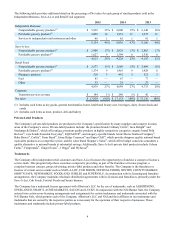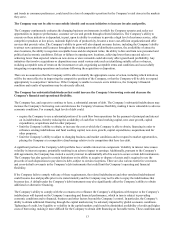Albertsons 2015 Annual Report Download - page 5
Download and view the complete annual report
Please find page 5 of the 2015 Albertsons annual report below. You can navigate through the pages in the report by either clicking on the pages listed below, or by using the keyword search tool below to find specific information within the annual report.3
CAUTIONARY STATEMENTS FOR PURPOSES OF THE SAFE HARBOR PROVISIONS OF THE SECURITIES
LITIGATION REFORM ACT
Any statements contained in this Annual Report on Form 10-K regarding the outlook for the Company’s businesses and their
respective markets, such as projections of future performance, guidance, statements of the Company’s plans and objectives,
forecasts of market trends and other matters, are forward-looking statements based on the Company’s assumptions and beliefs.
Such statements may be identified by such words or phrases as “will likely result,” “are expected to,” “will continue,”
“outlook,” “will benefit,” “is anticipated,” “estimate,” “project,” “believes,” “intends” or similar expressions. These forward-
looking statements are subject to certain risks and uncertainties that could cause actual results to differ materially from those
discussed in such statements and no assurance can be given that the results in any forward-looking statement will be achieved.
For these statements, SUPERVALU INC. claims the protection of the safe harbor for forward-looking statements contained in
the Private Securities Litigation Reform Act of 1995. Any forward-looking statement speaks only as of the date on which it is
made, and we disclaim any obligation to subsequently revise any forward-looking statement to reflect events or circumstances
after such date or to reflect the occurrence of anticipated or unanticipated events.
Certain factors could cause the Company’s future results to differ materially from those expressed or implied in any forward-
looking statements contained in this Annual Report on Form 10-K. These factors include the factors discussed in Part I,
Item 1A of this Annual Report on Form 10-K under the heading “Risk Factors,” the factors discussed below and any other
cautionary statements, written or oral, which may be made or referred to in connection with any such forward-looking
statements. Since it is not possible to foresee all such factors, these factors should not be considered as complete or exhaustive.
Competition
• The Company’s ability to attract and retain customers, and the success of the Company’s independent retailers and
licensees
• Increased competition resulting from consolidation in the grocery industry, and the Company’s ability to effectively
respond
• Competition from other food or drug retail chains, supercenters, hard discount, dollar stores, online retailers, non-
traditional competitors and alternative formats in the Company’s markets
• Customer reaction to the increased presence of competitors, including non-traditional competitors, in the Company’s
markets
• Competition for employees, store sites and products
• The ability of the Company’s Independent Business to maintain or increase sales due to wholesaler competition, increased
competition faced by customers and increased customer self-distribution
• Changes in economic conditions or consumer preferences that affect consumer spending or buying habits
• The success of the Company’s promotional and sales programs and the Company’s ability to respond to the promotional
and pricing practices of competitors
Execution of Initiatives
• The Company’s ability to identify and effectively execute on performance improvement and customer service initiatives
• The Company’s ability to offer competitive products and services at low prices and maintain high levels of productivity
and efficiency
• The ability to grow by driving sales, attracting new customers and new licensees and successfully opening new locations
• The ability to successfully execute on initiatives involving acquisitions or dispositions
• The Company’s ability to continue to become a more cost-efficient organization
• The Company’s ability to respond appropriately to competitors’ initiatives
Substantial Indebtedness
• The impact of the Company’s substantial indebtedness, including the restrictive operating covenants in the underlying debt
instruments, on its business and financial flexibility
• The Company’s ability to comply with debt covenants or to refinance the Company’s debt obligations
• A downgrade in the Company’s debt ratings, which may increase the cost of borrowing or adversely affect the Company’s
ability to access one or more financial markets
• The availability of favorable credit and trade terms
Labor Relations
• The Company’s ability to renegotiate labor agreements with its unions
• Resolution of issues associated with rising pension, healthcare and employee benefit costs
• Potential for work disruption from labor disputes

